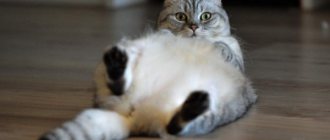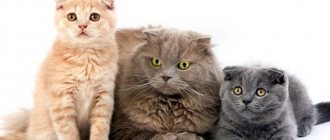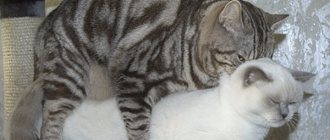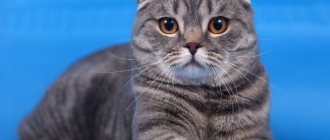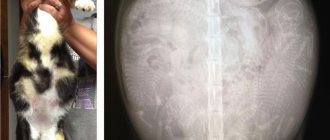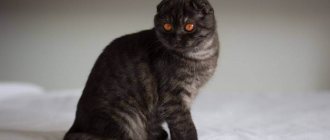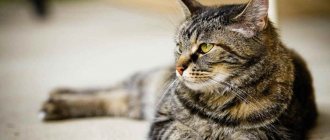Scottish cats are ideal mustachioed friends for any person. They have many undeniable qualities: cleanliness, calm disposition, unobtrusiveness, the ability to exist peacefully with other pets. Scottish cats are especially good-natured, which is why female cats so often start families. Scottish boys, as a rule, have a more independent character and prefer to keep the owner and other family members at a distance.
At first, when the Scottish girl is very small, the owner does not have any special problems. It is important to choose the right diet, take care of timely vaccination against severe infectious diseases, and the general health of the pet. But already from adolescence, when the animal is 8 months old, the owner will have to face a choice: whether to allow the pet to give birth to kittens or to deprive her of motherhood. If you still plan to mate a cat with a male, then the owner will certainly be faced with questions about the pregnancy of his pet. At what age can a pet be allowed to breed? How long does pregnancy last in Scottish cats, what are the symptoms of an “interesting” situation? How to behave correctly if there is a cat in the house expecting offspring? We will be looking for answers to these questions.
First signs of cat pregnancy
Once pregnant, a cat often becomes lethargic and drowsy. In the first 10 days, morning sickness is possible. The animal's behavior changes; it can become either aggressive or overly affectionate. Appetite increases, taste preferences may change. The nipples turn pink and swell, this becomes especially noticeable by day 21.
Two weeks after mating, the veterinarian can determine pregnancy by palpation or ultrasound. You cannot palpate the cat’s belly yourself (!), so as not to injure the embryos. If the mating was planned, it is recommended to immediately start a pregnancy calendar, which will help you adjust the diet at the right time and contact a veterinarian in time if the gestation period is delayed.
At what age can you knit tartan?
The age of the first heat in Scottish females is 8-10 months. But you shouldn’t rush to find a successful cat partner right away. It is better to wait until your pet is at least a year and a half old. Otherwise, if a cat becomes pregnant while very young, misfortune may occur - stillborn or weakened babies. Sometimes early birth even entails the death of a young mother.
By the way, before the first heat or after it (it is important that the cat is more than six months old), you can contact a veterinarian to remove the purr’s ovaries. This operation will save the cat from becoming pregnant, and the owner will not have to worry about problems while bearing babies.
Timing and duration
Now let's look at how long a cat's pregnancy lasts. As a rule, representatives of the Scottish Fold breed can carry offspring for 60 to 65 days.
The length of pregnancy depends on a number of factors:
- Weights. Large animals tend to bear kittens longer than normal, while small animals (up to 3 kg) sometimes give birth prematurely.
- Age. The first pregnancy, especially if the cat is not yet 1 year old, sometimes ends in birth after 50 days. This usually leads to the death of the offspring.
- Number of kittens. The more there are, the shorter the pregnancy will last.
- Health status. Illness and weakness of the animal can cause miscarriage.
Using the cat's pregnancy calendar, make sure that pregnancy does not prolong the pregnancy. If birth has not occurred on days 68–69, you must call a veterinarian.
If the fruits are dead...
Sometimes a phenomenon called fetal resorption in a cat can occur, in which resorption (resorption) of the fetus occurs in the uterus. This undesirable effect occurs under various unfavorable conditions: the cat’s health condition and external factors. If the fetus dies in the early stages, while the skeletal system is not formed, this most often passes without negative consequences for the cat’s health. If resorption occurs in the later stages, then such phenomena as mummification (drying), maceration (softening of tissues), petrification (deposition of lime) and putrefaction (putrefactive decomposition) are observed. Such conditions can be life-threatening for the cat and require veterinary intervention.
Features of care and contraindications during this period
A pregnant cat requires the most careful handling. It is better not to pick her up; at least, hold her under her butt and breasts without touching her stomach. Medicines (even mild ones) can only be given as prescribed by a veterinarian. Worms cannot be removed at this time.
Related article: Diseases and vaccinations of Scottish Fold cats
It is not recommended to let your cat outside to avoid injury and infection. It is important to protect her from drafts and hypothermia, to ensure that she does not climb onto high furniture, much less jump from there. Loud sharp sounds, turmoil or fright can cause a miscarriage, and if the term is late, on the contrary, a delay in labor. At this time, it is better to isolate the animal from small children.
Please note that a pregnant cat may go into heat. This happens due to living together with a cat or hormonal imbalance. At this time, re-fertilization is possible, but most often it ends in the death of either the “younger” litter or all the kittens. In rare cases, a cat gives birth to both “generations” in succession, but in this case she most often does not have enough milk. Therefore, if you have a couple of animals, it is better to keep your Scottish cat separately during pregnancy.
Another important question is what to feed a pregnant cat. At this time, you cannot transfer the animal from natural feed to industrial feed, and vice versa. Such a change in diet in itself is a burden for the body. When eating natural food, it is important that the diet contains a lot of protein: veal, dairy products, fish, eggs. Vegetables are also important. If you prefer to feed your pet commercial food, you need to choose a type specifically for pregnant and lactating cats.
Nutrition should include a full range of vitamins and microelements. Calcium is especially important. A veterinarian should select nutritional supplements. In the first weeks, food volumes should remain the same, but for weakened animals they can be increased by 10–15%. Gradually, meals are made fractional; by the middle of pregnancy, the frequency of feeding should reach 4–5 times a day. Initially, small portions are gradually increased. By the end of the period they should have grown approximately 2 times.
Related article: What you need to know about mating Scottish Fold cats
For constipation, you can give your cat vegetable oil.
What is considered a deviation from the norm
As mentioned earlier, there are standards that show that the duration of pregnancy in Scottish cats is 65 days . However, there are also indicators that should cause concern.
A deviation from the norm is considered:
- If kittens are born earlier than 60 days from the start of pregnancy. In this case, the litter will simply die, as it will not be capable of life.
- If the kittens do not appear after 67 days, then this is also not a normal course of pregnancy. From the 68th day, the litter will be considered post-term. In this case, you should urgently take the cat to the veterinarian.
Superfetation
Superfetation is an interesting phenomenon that manifests itself in the form of a second pregnancy during an existing pregnancy. That is, if a Scottish cat’s pregnancy has been going on for some time, but suddenly she begins to “walk” and then the cat is re-fertilized, then there is a possibility of a “double” litter.
Of course, superfetation is more of a hormonal problem. When a problem occurs in a cat’s head and her body does not produce the proper level of progesterone.
The first and main sign of possible superfetation is estrus in a pregnant Scottish cat. It is at this moment that if a cat is allowed near her, then re-fertilization can occur.
Estrus can begin when the duration of pregnancy of a Scottish fold or straight-eared cat has reached 20-40 days.
If superfetation occurs, then several scenarios are possible:
- The first and second litters will be miscarried at the same time.
- The first healthy litter will be born and the second will be premature and dead.
- The first litter will be born and after a while the second litter.
© shutterstock
Even if events develop according to the third option, there is a possibility that the cat will not have enough milk to feed two litters in a row. Therefore, it is best to avoid superfetation.
Preparing for childbirth
Preparations for the birth of a Scottish cat need to begin in advance. A week before the approximate date, have a preventive examination with a veterinarian and arrange in advance for emergency care in case of need. Create as quiet and calm conditions as possible for your cat. Try to keep other pets away from her and do not allow children to disturb the animal.
Prepare a convenient box lined with old newspapers or blankets. Reward your animal for sleeping and resting inside. Bowls with food and water, as well as a tray, should be placed nearby. The box should be about 50x50x50 cm. An entrance is cut on one of the walls with a threshold 10–15 cm high so that the cat can easily climb inside, but small kittens have no way to get out.
You also need to prepare disposable diapers, scissors, alcohol for disinfection, thread, Vaseline and a heating pad in advance.
Nuances and possible complications
Scottish Fold cats that bear kittens require special supervision from the owner. To avoid complications and maintain the health of the furry beauty and her offspring, the owner of the animal should invite a veterinarian if he notices the following symptoms:
- complete lack of appetite in the cat for more than 2 days at the beginning or middle of pregnancy;
- the appearance of discharge long before birth;
- fever, lethargy;
- the gestational age exceeded 68 days.
Attention! If labor begins in a cat 2-5 days earlier, you need to call a doctor at home.
False pregnancy
Each Scottish Fold has its own type of nervous organization and individual hormonal background. Under the influence of unfavorable factors, symptoms of a so-called false pregnancy may develop:
- the appearance of discharge from the vulva;
- frequent licking;
- enlargement of the abdomen and nipples;
- onset of lactation;
- increased and then decreased appetite;
- bowel disorders.
Treatment in this case is prescribed only by a doctor. Before contacting a specialist, you should limit your cat's intake of milk and reduce food portions.
Frozen pregnancy
The viability of the cubs is determined by the doctor after 2 weeks after fertilization. If there is a suspicion that the embryos have died, the animal is given an ultrasound.
The causes of missed abortion are usually infectious diseases, hormonal disorders, and pathological processes. Not all embryos may die, and then they do not interfere during pregnancy, and the mother gives birth to non-viable cubs along with the living ones.
If a Scottish Fold cat is diagnosed with a frozen pregnancy with complete death of kittens, the animal is induced to give birth and all pregnant cubs are removed. This must be done to save the mother from infection with decomposition products. If postoperative complications develop, the animal is sterilized.
Superfetation
Scottish Fold cats can go into heat even if they are already pregnant. Repeated sexual contact with the same partner (superfetation) in such animals leads to the beginning of a parallel process - a second pregnancy. It occurs simultaneously with the first. Another male can also fertilize a cat for the second time - this is called superfecundation.
In most cases, this situation ends badly - with a miscarriage or the death of one of the litters. Even if a cat carries and manages to give birth to all the cubs, it will be very difficult for her to feed the offspring. Therefore, it is very important to isolate the expectant mother from adult cats.
What are the dangers of early pregnancy?
Despite the fact that teenage cats are physiologically capable of giving birth as early as 7–8 months, experts recommend against mating such young animals. Scottish Fold cats that are under one year of age often give birth to weak or dead kittens, no matter how much care they take.
After such stress, the animal takes a long time to recover, rarely recovering earlier than after 6 months. If a cat develops complications due to an unsuccessful birth, she will need long-term therapy, and possibly sterilization.
Childbirth process
When a cat is preparing to give birth, her behavior changes noticeably. She regularly licks her crotch and breathes frequently. Representatives of this breed often try to attract the attention of their owners and achieve their presence near the box, often rubbing against their legs, meowing and purring.
It is advisable that the birth of a Scottish Fold cat take place under supervision. You should not interfere too actively in the process unless there is a clear need for it. If the contractions are weak, you can carefully pull the kitten towards you, after lubricating your hands with Vaseline. You need to hold him by the withers. If the cat does not expel the placenta on its own, it must be carefully pulled out.
The umbilical cord of a newborn kitten is tied with thread, disinfected and cut at a distance of 2 cm from the abdomen. The cat should lick and feed the baby, after which it can be placed on a heating pad covered with bedding. The average interval between the birth of kittens is 30–60 minutes.
Related article: How long do Scottish Fold cats live?
How to help a Scottish woman during childbirth
The first aid before lambing is preparing the den. The simplest option is a cardboard box with holes cut for ventilation, lined with paper and covered with a soft cloth. The future house for kittens is placed in a secluded place. The nesting cat is picked up and placed in a prepared place. If the cat shows willfulness and lambs in another place. She, along with her offspring, is placed in a prepared den, from which she will never leave.
It is good if a veterinarian is present during the birth, but most owners can provide assistance on their own. Most often, the cat copes on its own.
Be sure to read:
Miscarriage in a cat: symptoms, reasons, what to do, why kittens are born dead
Labor begins with the release of amniotic fluid. The kitten is born in the amniotic sac, which bursts and the cat gnaws the umbilical cord. If she did not do this, you need to cut the cord with sterile scissors and treat the stump with tincture of iodine. The mother usually eats the placenta. This is normal, but you should not allow more than two placentas to be eaten. When the cat has the intention of eating another afterbirth, food is added to it.
If the bubble does not open on its own, it is broken with your fingers. The kitten is shaken, the liquid is removed from the mouth with a baby syringe and placed on the mother.
The normal interval between the births of kittens is considered to be a quarter of an hour. All afterbirths come out within half a day after the birth of the last kitten. If labor is difficult, call a veterinarian.
Behavior of a pregnant fold cat
A pregnant cat changes its behavior. Hormonal surges change behavior. The cat alternately pets and looks irritated. Fetal development increases food requirements during the fourth week of pregnancy. At that time, the feed portion can be increased by 10-15%. In subsequent weeks, the animal is no longer restricted in food, but in order to avoid overeating, it is fed in small portions, but often.
The best option is to switch to ad libitum feeding with dry granules. The fifth week of pregnancy has only just begun, and the Scotswoman is already beginning to nest: she is looking for a secluded place. If the owners are planning to purchase a cat house, then this time is most suitable for the implementation of the intention.
During the seventh week, the cat may lose its appetite for a while. The embryos begin to grow fur and the cat hibernates at this time. The body is rebuilt, some of the nutrients are redirected into the formation of fruits to prepare the mammary glands for lactation. This process requires calmness, so the cat becomes drowsy.
In the last weeks before lambing, the Scotch cow becomes active again, once again walking around the property in search of a more convenient nest. It's time to satisfy your curiosity and repeat the ultrasound. You can determine the number of fruits and observe their movements. However, someone may be undetected and the actual number of kittens turns out to be greater than expected.
Behavior by week
First - third week. At the very beginning, the pussy becomes very lazy, sleeps a lot, and may not eat. But she constantly caresses, asks for love and ironing.
The nipples become pink, and sometimes there is nausea. At this time, provide her with enough human warmth, caress her, speak in a calm voice, pay attention, because she needs it. Try to explain to the children, if you have them in your house, so that they do not disturb her again, do not carry her in their arms and do not wake her up if she falls asleep. This should be done throughout the entire period.
Fourth – sixth week. You will notice that the female has become rounder in the sides; if you gently touch the tummy, you can feel the embryos there. Make sure that she does not show excessive activity, because her center of gravity is now shifted and she may not be able to maintain her balance. Clumsiness is dangerous and causes injury, so remove any chairs that she can jump on and end up on top of a cabinet, etc. If you see that it has nevertheless climbed somewhere, carefully remove it without putting pressure on the belly.
Seventh – ninth week. The animal's mobility is completely limited, it sleeps a lot and walks around all the rooms, inspecting the corners. This is a search for a place for babies to be born. You need to prepare a box, soft cloth and everything you need to deliver the baby. There is no need to disturb or irritate the animal; you should reduce the amount of food and monitor it - the process can begin at any time.
The Scottish breed is artificially bred, so the instincts may not be as strong as in others; be prepared to provide assistance, cut the umbilical cord, take the Scottish dog to the veterinary clinic or call a doctor at home. In any case, keep the hospital phone number at hand, if necessary, they can provide you with advice.
Harbingers of childbirth among sphinxes
Don and Canadian Sphynxes are exemplary and caring mothers for their little kittens. The gestation period lasts from 58 to 72 weeks. In most cases, cats of this breed produce from 3 to 5 kittens per lamb.
The first signs of the onset of labor in sphinxes appear 2 days before the upcoming event. Two days before the onset of labor, the body temperature in the rectal canal drops to 36.7 degrees. The cat begins to actively groom and wash the genital area.
A few hours before giving birth, the cat begins to arch its back and show pronounced anxiety. Otherwise, the signs of beginning labor are similar to other cat breeds, and the birth process itself takes about 12 hours before the last kitten emerges.
Note! If your pet's contractions last longer than 3-4 hours without pushing, you should contact a veterinarian for help.
When does the countdown start?
In order to correctly calculate the gestational age of Scottish and British women, you need to know when the mating took place. If the mating date is unknown, you should expect the first signs of pregnancy. Since ovulation occurs during the mating process, sexual intercourse is considered the beginning of fetal formation.
Changes in behavior and signs of pregnancy
While carrying a fetus, the animal gains significant weight and moves less.
Symptoms of pregnancy in straight-eared and fold-eared Scots:
- weakness and low activity;
- nausea and vomiting;
- the animal becomes rounder and gains weight;
- nipples swell and tastes change;
- appetite increases;
These signs appear by the 3-4th week, they are short-term. This condition is due to the fact that changes occur in the animal’s body: hormonal levels change, the uterus grows and develops. In the early stages, an animal’s pregnancy can be determined by a veterinarian using an ultrasound or during an examination, approximately in the second week of pregnancy. It becomes obvious and noticeable by 6 weeks.
Stages of pregnancy
Presented in the table:
| A week | Peculiarities |
| 1—3 | No visible signs |
| A clear indicator is toxicosis, its duration is from a couple of days to a week | |
| Drowsiness and fatigue appear | |
| Fetuses begin to develop in the uterus; on average, cats give birth to 4-5 cubs | |
| 4 | The cat's mood changes |
| Hormonal levels change | |
| Increased risk of miscarriage | |
| Appetite increases | |
| The belly is getting bigger | |
| 5 | The belly increases significantly due to the growth of the offspring, straight-eared Scottish women feel this and look for a comfortable place for future offspring |
| Due to her growth, the female loses her balance, so it is worth protecting her from jumping. | |
| 6 | The animal is inactive and drowsy |
| Light activity with toys is allowed | |
| 7 | The offspring begins to move in the mother's belly |
| Due to its size, the cat cannot clean itself up on its own; its owner comes to its aid. | |
| After going to the toilet, a straight-eared cat needs to be cleaned of residues so that germs do not appear. | |
| Pet eats less | |
| 8 | Beginning preparations for childbirth |
| The animal is excited | |
| 9 | Swollen nipples are noticeable |
| The cat is inactive and sleeps a lot | |
| 10 | If an animal has been pregnant for 10 weeks, the cat is post-term, this is also part of the norm, since pregnancy lasts approximately 69 days. |
| If she has not given birth on days 68-69, you need to consult a doctor |
Cat care
During the gestation period, the number of daily servings increases.
The owner needs to pay attention to all changes in the pet’s behavior. Especially when the female gives birth for the first time. A pregnant cat needs to be fed high-calorie and nutritious food. The diet should contain vitamins and minerals. In the process of increasing the animal's appetite, the number of meals increases, but the volume remains the same. At the end of pregnancy, the cat's diet should consist of food for pregnant cats if she eats ready-made food. With a natural diet, the diet includes:
- boiled meat;
- low-fat boiled fish;
- boiled eggs;
- porridge;
- vegetables.
Symptoms
Let's look at how allergies to cats manifest themselves. In fact, the manifestations of an allergic reaction can be of different types.
Respiratory symptoms of a cat allergy:
- nasal congestion and allergic rhinitis;
- burning sensation and itching in the throat and nose;
- cough and sneezing;
- dyspnea;
- swelling of the nasopharynx.
Against the background of these symptoms, general weakness and even fever may occur.
The intensity of respiratory symptoms varies from person to person. For some, they appear after prolonged contact with a cat, while for others, an attack can begin literally when the animal appears.
Manifestations of a skin allergic reaction to cats:
- the appearance of irritation and itching on the skin;
- burning and itching;
- rash, blistering and redness.
Skin symptoms usually appear upon direct contact with the animal. If an allergic reaction is expressed only in this way, then it will be enough for the patient to simply minimize the risks of their manifestation - it is enough to exclude contacts with felines.
Allergic manifestations of food nature:
- nausea;
- pain syndrome in the stomach.
If an allergen gets into food, symptoms can manifest themselves in this way - a general deterioration in the condition, the urge to vomit and pain in the stomach. In this case, it is also important not to delay your visit to the doctor, so that the specialist has the opportunity to make the correct diagnosis as early as possible.
Other cat allergy symptoms:
- headache;
- lethargy and irritability;
- the appearance of swelling in the eye area, profuse lacrimation.
It should be noted that all of the listed symptoms are not unique and may indicate the development of another disease. Therefore, the key point is accurate diagnosis and determination of the cause of the symptoms that appear.
Are you experiencing cat allergy symptoms?
Only a doctor can accurately diagnose the disease. Don't delay your consultation - call
Mating
At approximately 8-9 months, the cat reaches puberty. However, the most suitable time for mating is the age of 1.5 -2 years. Cats are usually not bred during their first heat, since their bodies are not yet physically or mentally ready for pregnancy and childbirth.
It is better to pair her with a cat on her 2nd or 3rd heat. You should be very careful when choosing a partner for future mating. A fold-eared cat can only be crossed with a straight-eared Scotsman.
It is important to know that it is forbidden to cross a fold cat with a fold cat. As a result of such mating, sick offspring with various defects and defects may be obtained. A miscarriage is also possible.
For the first mating, it is necessary to select a more experienced male who has already had offspring. He must be well-groomed, have a healthy appearance, uniform coloring and trimmed nails.
A pedigree and a passport with vaccinations are required. A specialized Scots breeding club will help you find a suitable partner. Experienced specialists will advise and help you choose the most suitable cat in terms of parameters and external characteristics.
Puberty in cats
In a Scottish pet that comes into the family at the age of 3 months, sexual maturation can begin early, at 4.5 months. Physiologically, a Scots kitten will gain strength only after 9 months or later. The reproductive period, the gestation period comes after 10 months, lasts on average until 7-8 years of age. Premature pregnancy is harmful to the kitten’s fragile body.
The cat is in heat
Scots are a breed with average sexuality, so during the period of heat, many do not arrange unbearable concerts. The period of the first and all subsequent heats is difficult not to notice; within 3-4 days, the imperturbable Scottish woman’s behavior changes dramatically. She becomes either too affectionate or restless, runs after family members, and constantly makes sharp “meowing” sounds. Begins to mark the surrounding space around. These cat days are called estrus, rut, or hunting.
According to the nature of its passage, estrus can be divided into periods:
- The first one goes quite calmly. The cat develops small transparent discharge from its intimate parts, signaling the onset of estrus;
- In the second period, the character changes dramatically, the cat constantly screams heartbreakingly, emitting different sounds, calling out the cats. She may not eat, constantly raising and lowering her tail, periodically rolling on the floor or raising her butt.
- After a few days, she calms down and gradually returns to normal.
This is interesting: How Scottish Fold cats give birth
What is not allowed in an “interesting position”?
A cat's behavior changes during pregnancy, and you need to change your attitude towards it a little. What a cat should not do in this situation:
- jumping from heights can be dangerous;
- cannot be treated against fleas and helminths;
- do not give medications without consulting a veterinarian, they can harm the kittens;
- Do not feed spoiled food;
- do not drink tap water;
- pick it up carefully.
If a cat has always walked outside, you shouldn’t prohibit it from doing so now. When the due date approaches, she will be at home more often.
What owners should do and what not to do to preserve the gestation period of their offspring
In order for the cat to emerge within the prescribed period, the owners need to know several rules about what should be done and what should be avoided during this period, so that the duration does not change towards critical. Rules are not a panacea, because There is also a genetic predisposition, which “you can’t argue with.
What do we have to do:
- Contact a specialist as soon as possible after the expected conception to identify possible risks to the life and health of the fetus and for the mother cat. It is wise to use an ultrasound to find out if the cat is pregnant at all.
- Contact your veterinarian if Murka exhibits any strange behavior or changes in health (vomiting, fever, lack of appetite).
- Protect the pet from children so that they do not squeeze, kick or make any sudden movements towards the animal.
- Provide balanced and sufficient nutrition.
- If necessary, give vitamins for pregnant women (veterinary).
What not to do:
- Make Murka nervous. This includes purchasing new pets during this period, arranging noisy events indoors where the cat cannot hide, and allowing children in.
- Press the stomach tightly, supposedly trying to determine how many babies should be born. It is almost impossible to do this with your hands, especially for a non-specialist, and it is easy to injure the abdomen!
- Give any medications without consulting a veterinarian.
- Allow Murka to jump from a height or climb there.
- Washing or treating your home with strong and strong-smelling household chemical solutions is a direct path to poisoning.
- Allow contact with sick and abandoned animals.
- Do not follow the rules of hygiene (stroking with dirty hands after going outside or allowing you to sleep in the shoes you came in from the street in).
Symptoms and signs
After mating, it is possible to determine if a cat is pregnant only after 3-4 weeks. Previously, it did not appear in any way. Some symptoms:
- The cat's behavior changes, it becomes cautious and less active.
- Sometimes nausea is observed, and temporary refusal of food is observed.
- Later, on the contrary, appetite increases. The animal eats a little, but often.
- If the cat is pregnant for the first time, changes in the nipples can be seen in the second month. They increase in size and swell. Now they can be easily felt.
- The belly gradually rounds and grows.
The animal becomes less active
Not all cats will necessarily have the same characteristics. No two animals are the same, and their symptoms of pregnancy are different. Slender cats often give birth on time, while well-fed cats carry them to term. Also, the period depends on the number of fruits. If there are many of them, birth occurs later.
At a later stage, you can place your palm on the cat’s stomach and feel the kittens move. But you don’t need to put too much pressure on the stomach so as not to harm the offspring.
Duration of pregnancy in cats
It is impossible to designate an exact, uniform number of days for everyone. For each individual, this period proceeds in its own way, perhaps, like in humans, prematurity and postmaturity.
The number of days gestation for all felines is strongly influenced by a number of circumstances:
- how many embryos were formed in the female;
- how old (or even months) is the expectant mother;
- individual health characteristics.
The duration of an interesting situation in cats is on average nine weeks, and the possible number of days ranges from 58-72.
What to do with kittens?
Cats have a well-developed maternal instinct, so immediately after the birth of kittens, they independently gnaw the umbilical cord and provide full care for their offspring.
What help can the owner of a young mother cat provide:
- Kittens are practically blind after birth and bright sunlight can irritate their eyes. Try to find a suitable place in the house for the offspring, where there will be dim light, no drafts and no strong noise.
- For disinfection purposes, you can treat the kittens' umbilical cord with hydrogen peroxide or regular brilliant green.
- Make sure your mother cat licks her babies regularly. This process is very important, it improves the functioning of the kittens’ digestive organs and stimulates the sucking reflex.
- A mother cat feeds her babies with breast milk. You need to monitor this process and make sure that all kittens have access to the nipples and are fed.
- Newborn kittens must be kept in a warm room. If the room temperature is less than 28 degrees Celsius, install a heat lamp above the box with the babies. Just don’t point it directly at the babies, but slightly to the side to avoid burning the kittens’ delicate skin.
- If the mother cat does not have enough milk for feeding, organize complementary feeding. As additional nutrition, it is better to use special formulations from veterinary pharmacies, which are analogues of cat's milk. Your veterinarian will help determine the frequency of feeding kittens and the dosage of artificial milk.
- The box with the offspring should not stand at a height. This is very dangerous for growing children, who may unknowingly tip over the sides and fall, resulting in serious injuries.
